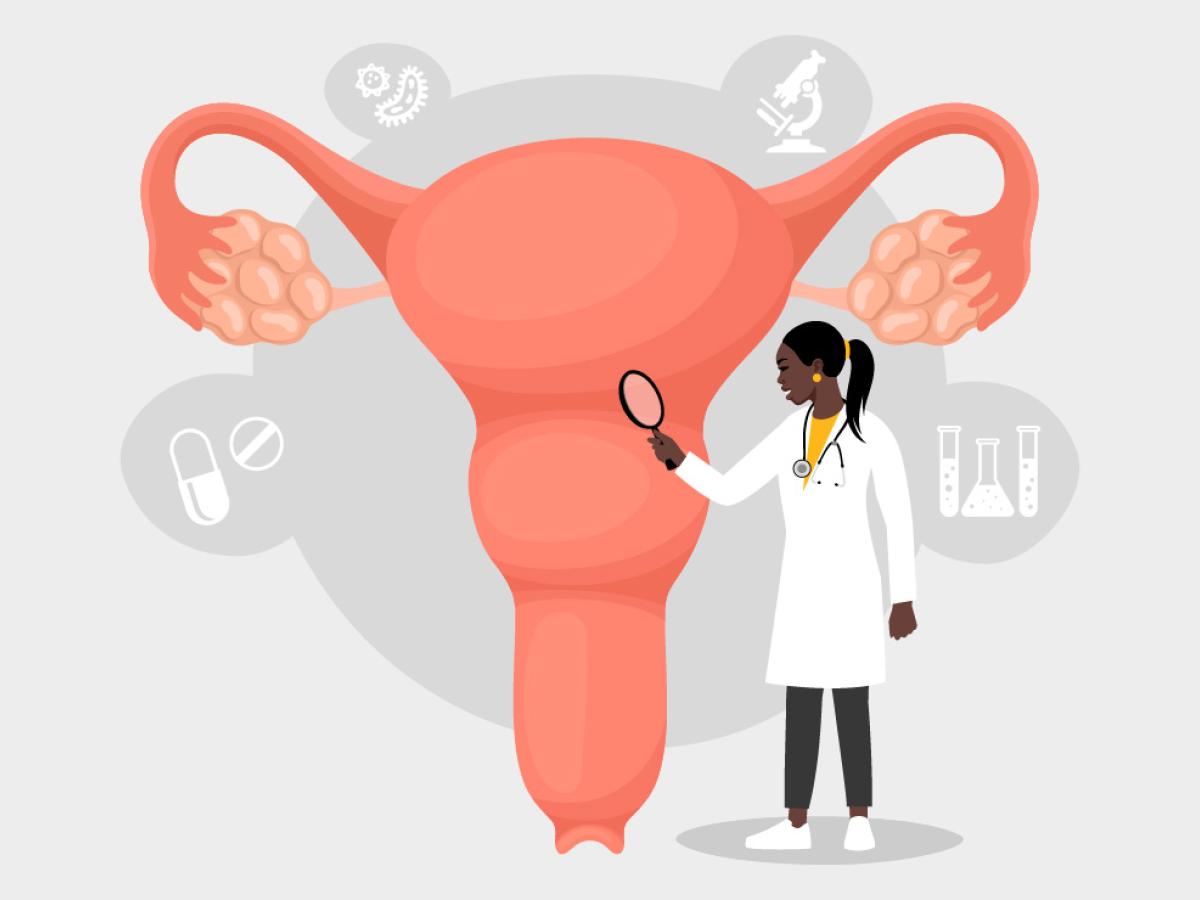December 19, 2023

Monthly periods aren’t exactly pleasant. But menstruation shouldn’t cause you severe pelvic pain and debilitating symptoms. If that’s happening, you may have an underlying issue like endometriosis.
What Is Endometriosis?
Women of childbearing years have endometrial cells lining their uterus. Each month, that lining sheds during their period. But about 10% of all women have endometrial cells growing outside their uterus — where they don’t belong. Those abnormal cells can grow and spread as endometriosis.

“Endometriosis is an estrogen-dependent, progesterone-resistant inflammatory disease that is associated with pain and infertility,” says Dr. Albert Hsu, an OB/GYN specializing in reproductive endocrinology and infertility. These abnormal cells — fueled by the hormone estrogen — attach to other organs and can grow and spread. It can cause lesions and ovarian cysts and cause pain and other monthly symptoms.
Experts are still learning about endometriosis, but Dr. Hsu shares six surprising facts to know about this disease:
1. No one knows what causes endometriosis.
It’s a common misconception that menstruation alone causes endometriosis — some people have endometriosis even without a monthly period. The truth is doctors are still unsure why endometriosis cells grow outside the uterus.
But experts suggest several possible causes, including:
- “Backwards” menstrual flow: It’s common for some blood and menstrual tissue to flow “backwards” through the fallopian tubes and into the pelvic cavity instead of flowing through the cervix and vagina and out of the body. It’s called “retrograde menstruation,” and it happens in the majority of women — though not all those women develop endometriosis.
- Hormonal imbalance: Endometriosis is an estrogen-dependent disease, meaning that estrogen promotes the growth and spread of abnormal cells. Though rare, even men have been reported to develop endometriosis after estrogen therapy. That being said, some women still report endometriosis pain after menopause when estrogen levels are low.
- Genetics: Endometriosis tends to run in families and appears to have a genetic component. If your parent or sibling has endometriosis, you are significantly more likely to develop it than someone without a family history.
“Even though retrograde menstruation is the most common theory for what causes endometriosis, it doesn’t explain all the cases we see,” Dr. Hsu says. “It’s a mysterious disease, and we still don’t completely understand all the different subtypes of endometriosis.”
2. Endometriosis can spread like cancer.
Endometriosis tissue is most often found in the pelvic region, implanting on organs such as the ovaries, bowel or bladder. But endometriosis has also been found outside the pelvis, such as in the lungs, brain and eyes.
While the evidence remains preliminary, some experts believe that endometriosis cells may be transported through the body through the blood or lymphatic system — similar to how cancer can spread.
“Endometriosis is considered benign,” Dr. Hsu says. “But endometriosis tissue is similar to cancer in terms of how it spreads to different parts of the body. I’ve seen endometriosis present in umbilical hernias and cesarean-section scars. Interestingly, some women with endometriosis of the lungs will even cough up blood every time they have their period.”
3. Endometriosis symptoms are often not clear-cut.
The symptoms of endometriosis exist on a spectrum — some women have no symptoms at all (“silent” endometriosis) while others suffer from severe chronic pain that affects their quality of life. But in 75% of endometriosis cases, pelvic pain is a major symptom.
“The classic pain symptoms associated with endometriosis include painful intercourse, painful menstruation and other monthly pains that coincide with the menstrual cycle, such as pain during ovulation or painful bowel movements during a menstrual period,” Dr. Hsu says. “But the complicated thing about pain is that it can manifest in many ways.”
He points to other common signs he sees, such as painful urination or painful bowel movements during periods. Endometriosis also tends to occur with other medical conditions, including:
- Migraines
- Irritable bowel syndrome
- Inflammatory bowel disease
- Interstitial cystitis, or painful bladder syndrome
- Chronic fatigue syndrome
- Fibromyalgia
- Sciatica
- Scoliosis
It may be hard to distinguish signs of endometriosis from symptoms associated with these other conditions. “It’s possible to have a dual diagnosis,” Dr. Hsu says. “That’s what makes endometriosis so challenging to address.”
4. Getting an official endometriosis diagnosis requires surgery.
Endometriosis can be challenging to diagnose. In addition to the wide range of symptoms and unclear causes, there are no simple blood or urine lab tests for endometriosis. The only way to accurately diagnose endometriosis is with an abdominal surgery like a laparoscopy or laparotomy. In some cases, the surgeon can remove or destroy endometriosis tissue during the surgical procedure.
Some people may live years with undiagnosed endometriosis. If symptoms are mild or successfully managed by pain medication or hormonal birth control, a surgical diagnosis may not even be necessary.
“The incidence of endometriosis has gone down nationally because we’re doing less surgery for pain or for infertility,” Dr. Hsu says. “If someone has pain possibly associated with endometriosis, you can often treat them with hormones such as birth control pills or an intrauterine device (IUD). We only get a definitive diagnosis after surgery.”
5. There’s no cure for endometriosis.
There is no proven way to stop or prevent endometriosis, but there are ways to treat the symptoms. Over-the-counter pain relievers can help with mild symptoms. Hormonal therapies, such as progestin-only birth control pills, combined oral contraceptive pills, and progestin IUDs, can help address “progesterone resistance”. These hormones generally make periods less heavy and less painful, and the progestin IUD can even eliminate periods entirely, while relieving many of the endometriosis-associated pain symptoms.
Surgery may be an option, especially if there is a large ovarian cyst containing endometriosis, or if severe symptoms don’t respond to hormonal therapies. Surgeons will often use minimally- invasive techniques to locate and remove or ablate (burn) areas of endometriosis. But surgery is often not a long-term solution for pain.
“Data shows that surgery alone is not a permanent treatment,” Dr. Hsu says. “Within two years, most women (75%) report that pain comes back unless they are on some sort of hormonal treatment following the surgery.”
6. Your childbearing plans guide endometriosis treatment.
Doctors may not fully understand endometriosis, but they do know there appears to be a significant connection between endometriosis and fertility:
- Endometriosis can be associated with infertility — up to 40% of infertility cases involve endometriosis.
- Fertility treatments are also less likely to work in many people with endometriosis.
- Many hormonal treatments for endometriosis pain will block fertility in a variety of ways associated with birth control, such as preventing ovulation or implantation, reducing motility, creating a thinner uterine lining, etc.
“There are no treatments for endometriosis pain that are both safe and effective in women who are trying to conceive,” Dr. Hsu says. “My number one question for anyone with pain and suspected endometriosis is, ‘What are your plans for childbearing?’ The answer determines the direction of treatment pathways.”
If You Suspect You May Have Endometriosis…
Diagnosing endometriosis is complicated and not something you can try to do on your own, Dr. Hsu says. Relay your concerns to your primary care doctor or OB/GYN, who can begin the diagnostic process and help manage your pain.
If you have chronic pain that you suspect is connected to endometriosis, Dr. Hsu also recommends taking these steps:
- Educate yourself about endometriosis: Make sure the information you have is accurate. Dr. Hsu recommends consulting a reputable source such as the American Society of Reproductive Medicine or the American College of Obstetricians and Gynecologists.
- Know your body: Keep a health diary. Write down any symptoms you have and include the timing of those symptoms with your menstrual cycle to try to identify patterns.
- Keep a food diary: Experts suspect that certain foods may be associated with endometriosis, either negatively or positively. Discuss your food diary with your doctor or a dietitian, who may recommend dietary changes to reduce your symptoms.
- Learn your family history: Let your doctor know if endometriosis or other conditions run in your family. That information may help inform the diagnostic process.
Next Steps and Useful Resources
- Want to speak with a doctor? Find one today.

